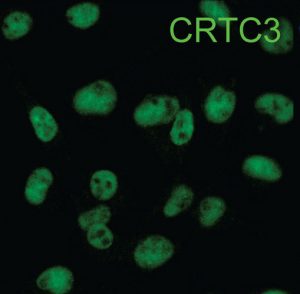
May 18, 2021
Study suggests that turning molecular switch off could be a strategy to treat deadly type of skin cancer
Study suggests that turning molecular switch off could be a strategy to treat deadly type of skin cancer
LA JOLLA—Despite only accounting for about 1 percent of skin cancers, melanoma causes the majority of skin cancer-related deaths. While treatments for this serious disease do exist, these drugs can vary in effectiveness depending on the individual.
A Salk study published on May 18, 2021, in the journal Cell Reports reveals new insights about a protein called CRTC3, a genetic switch that could potentially be targeted to develop new treatments for melanoma by keeping the switch turned off. “We’ve been able to correlate the activity of this genetic switch to melanin production and cancer,” says Salk study corresponding author Marc Montminy, a professor in the Clayton Foundation Laboratories for Peptide Biology.

Melanoma develops when pigment-producing cells that give skin its color, called melanocytes, mutate and begin to multiply uncontrollably. These mutations can cause proteins, like CRTC3, to prompt the cell to make an abnormal amount of pigment or to migrate and be more invasive.
Researchers have known that the CRTC family of proteins (CRTC1, CRTC2, and CRTC3) is involved in pigmentation and melanoma, yet obtaining precise details about the individual proteins has been elusive. “This is a really interesting situation where different behaviors of these proteins, or genetic switches, can actually give us specificity when we start thinking about therapies down the road,” says first author Jelena Ostojić, a former Salk staff scientist and now a principal scientist at DermTech.
The researchers observed that eliminating CRTC3 in mice caused a color change in the animal’s coat color, demonstrating that the protein is needed for melanin production. Their experiments also revealed that when the protein was absent in melanoma cells, the cells migrated and invaded less, meaning they were less aggressive, suggesting that inhibiting the protein could be beneficial for treating the disease.
The team characterized, for the first time, the connection between two cellular communications (signaling) systems that converge on the CRTC3 protein in melanocytes. These two systems tell the cell to either proliferate or make the pigment melanin. Montminy likens this process to a relay race. Essentially, a baton (chemical message) is passed from one protein to another until it reaches the CRTC3 switch, either turning it on or off.
“The fact that CRTC3 was an integration site for two signaling pathways—the relay race—was most surprising,” says Montminy, who holds the J.W. Kieckhefer Foundation Chair. “CRTC3 makes a point of contact between them that increases specificity of the signal.”
Next, the team plans to further investigate the mechanism of how CTRC3 impacts the balance of melanocyte differentiation to develop a better understanding of its role in cancer.
DOI: 10.1016/j.celrep.2021.109136
JOURNAL
Cell Reports
AUTHORS
Jelena Ostojić, Young-Sil Yoon, Tim Sonntag, Billy Nguyen, Joan M. Vaughan, Maxim Shokhirev, Marc Montminy
Office of Communications
Tel: (858) 453-4100
press@salk.edu
Unlocking the secrets of life itself is the driving force behind the Salk Institute. Our team of world-class, award-winning scientists pushes the boundaries of knowledge in areas such as neuroscience, cancer research, aging, immunobiology, plant biology, computational biology and more. Founded by Jonas Salk, developer of the first safe and effective polio vaccine, the Institute is an independent, nonprofit research organization and architectural landmark: small by choice, intimate by nature, and fearless in the face of any challenge.